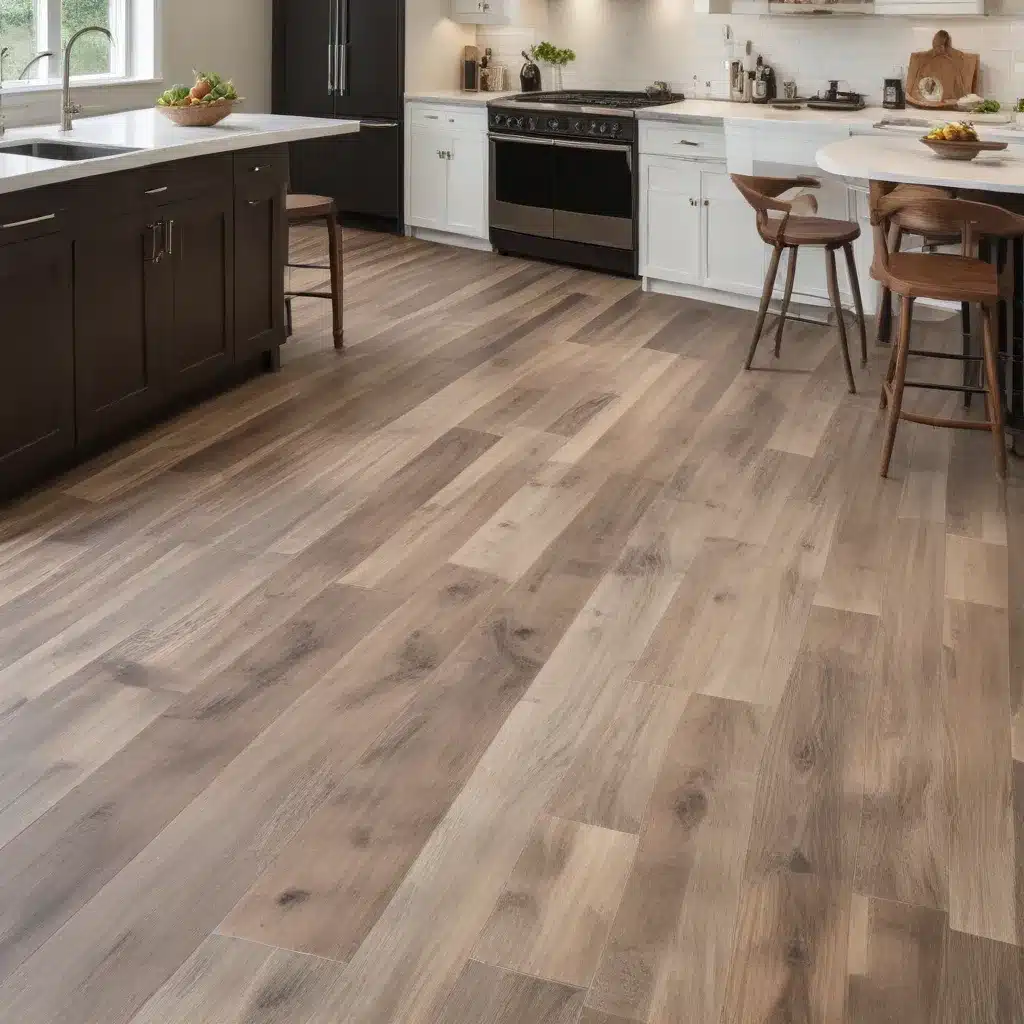
As a seasoned construction professional and interior designer, I’m excited to share my insights on sustainable flooring options that can elevate your kitchen renovation. In today’s climate-conscious world, homeowners are increasingly seeking flooring solutions that not only look great but also minimize their environmental impact.
Exploring Eco-Friendly Flooring Materials
When it comes to sustainable flooring, there are several materials worth considering for your kitchen renovation. Let’s dive into the top eco-friendly options and their unique advantages.
Cork Flooring: A Natural Marvel
Cork is a highly renewable and sustainable material derived from the bark of the cork oak tree. This natural insulator is not only durable and water-resistant but also incredibly comfortable underfoot. Cork flooring is available in a wide range of colors and patterns, allowing you to create a visually striking and personalized look in your kitchen. Additionally, cork is naturally resistant to mold, mildew, and pests, making it a low-maintenance choice for high-traffic areas like the kitchen.
Bamboo: A Fast-Growing Powerhouse
Bamboo is one of the fastest-growing plants on the planet, with a harvest cycle of just three to five years. This renewable resource is an excellent alternative to traditional hardwood floors, offering a similar aesthetic and durability. Bamboo flooring is often praised for its dimensional stability, scratch-resistance, and ease of maintenance. However, it’s essential to ensure that the bamboo you choose is sourced from sustainably managed forests to minimize its environmental impact.
Reclaimed Wood: Giving New Life to Old Treasures
Reclaimed wood flooring is a fantastic option for those seeking a unique and eco-friendly solution. By repurposing wood from old buildings, barns, or other structures, reclaimed wood flooring not only saves valuable resources from landfills but also adds a captivating, one-of-a-kind character to your kitchen. These floors often feature a rustic charm, with knots, distressed textures, and variations in color that no new wood can replicate.
Linoleum: A Resilient and Renewable Choice
Linoleum is a classic flooring material that has experienced a resurgence in popularity due to its eco-friendly credentials. Made from natural ingredients like linseed oil, cork, and wood flour, linoleum is a durable, water-resistant, and easy-to-clean choice for kitchen floors. Unlike vinyl, which is petroleum-based, linoleum is a renewable resource that can be composted or burned as fuel at the end of its lifespan.
Recycled Carpet: A Sustainable Softness
While carpet may not be the first choice for kitchen flooring, recycled carpet tiles can be a surprisingly eco-friendly and practical option. These tiles are made from reclaimed materials, including post-consumer and post-industrial waste, which helps divert them from landfills. Recycled carpet tiles are available in a variety of colors and patterns, and they can provide a soft, comfortable surface underfoot, especially in areas where you tend to stand for extended periods.
Balancing Aesthetics, Durability, and Sustainability
When it comes to selecting the perfect sustainable flooring for your kitchen renovation, it’s essential to strike a balance between aesthetics, durability, and environmental impact.
Aesthetics: Consider how the flooring material will complement the overall design and style of your kitchen. Whether you prefer a modern, industrial look or a more traditional, farmhouse-inspired aesthetic, there are eco-friendly options that can seamlessly integrate with your desired aesthetic.
Durability: Kitchen floors need to withstand heavy foot traffic, spills, and various kitchen activities. Ensure that the sustainable flooring you choose is up to the task, with features like water resistance, scratch-resistance, and easy maintenance.
Sustainability: Look for flooring materials that are renewable, biodegradable, or made from recycled content. Prioritize products that are locally sourced or have a low carbon footprint from manufacturing and transportation.
To help you navigate the options, I’ve compiled a comparative table showcasing some of the top sustainable flooring choices for your kitchen renovation:
| Flooring Material | Renewability | Durability | Comfort | Cost (per sq. ft.) |
|---|---|---|---|---|
| Cork | Highly renewable | Excellent | Excellent | $3 – $12 |
| Bamboo | Highly renewable | Excellent | Good | $2 – $5 |
| Reclaimed Wood | Renewable (from recycled sources) | Excellent | Good | $12 – $30 |
| Linoleum | Renewable | Excellent | Good | $2 – $7 |
| Recycled Carpet | Renewable (from recycled sources) | Good | Excellent | $3 – $12 |
Remember, the right sustainable flooring choice for your kitchen renovation will depend on your specific needs, budget, and design preferences. I encourage you to visit the Local Builder London website to explore more options and connect with experienced professionals who can guide you through the decision-making process.
Incorporating Sustainable Practices Beyond Flooring
Choosing eco-friendly flooring is just one aspect of a sustainable kitchen renovation. As a construction professional and interior designer, I also recommend considering the following sustainable practices to further enhance the environmental impact of your project:
- Utilize energy-efficient appliances: Select Energy Star-rated appliances that consume less energy and reduce your carbon footprint.
- Incorporate natural lighting: Maximize the use of natural light through strategically placed windows and skylights to minimize the need for artificial lighting.
- Implement water-saving features: Install low-flow faucets, water-efficient dishwashers, and other water-conserving solutions to reduce water consumption.
- Opt for sustainable cabinetry and countertops: Look for cabinetry made from recycled or sustainably sourced materials, and choose countertops like quartz or recycled glass that have a lower environmental impact.
- Prioritize local and ethical suppliers: Support local businesses and artisans, and choose products and materials that are ethically sourced and manufactured.
By taking a comprehensive approach to sustainable practices, you can create a kitchen that not only looks and functions beautifully but also aligns with your values and reduces your environmental footprint.
Remember, sustainable living is a journey, and every step you take towards a greener, more eco-friendly home can make a meaningful difference. I hope this article has provided you with valuable insights and inspiration to make your kitchen renovation a true testament to sustainable design.


